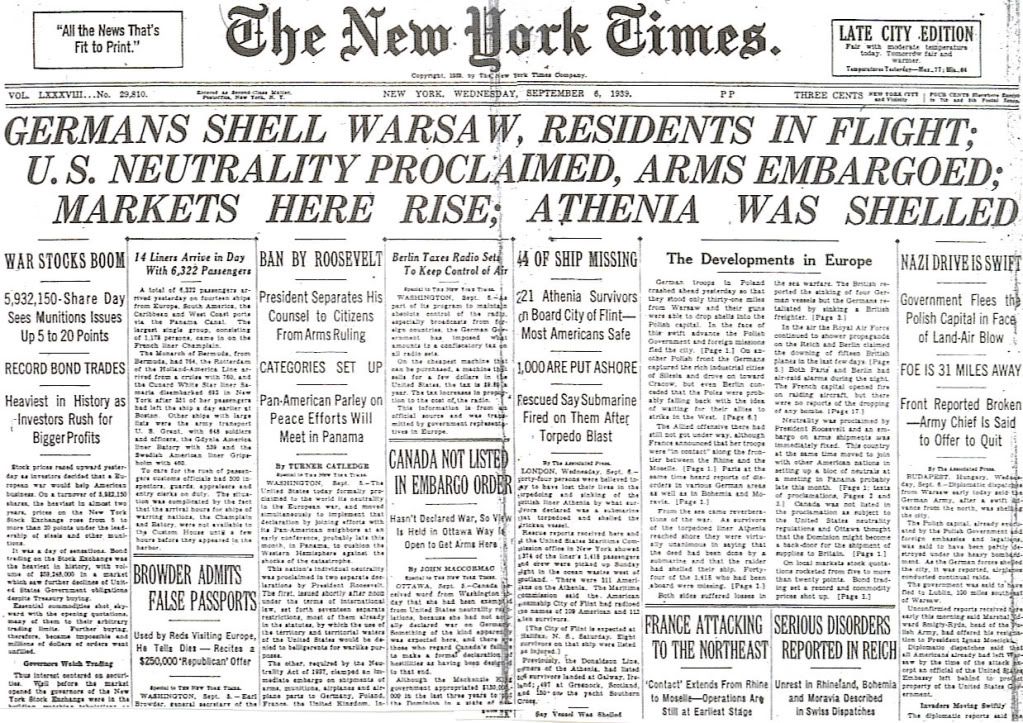
Posted on 09/06/2009 6:03:06 AM PDT by Homer_J_Simpson

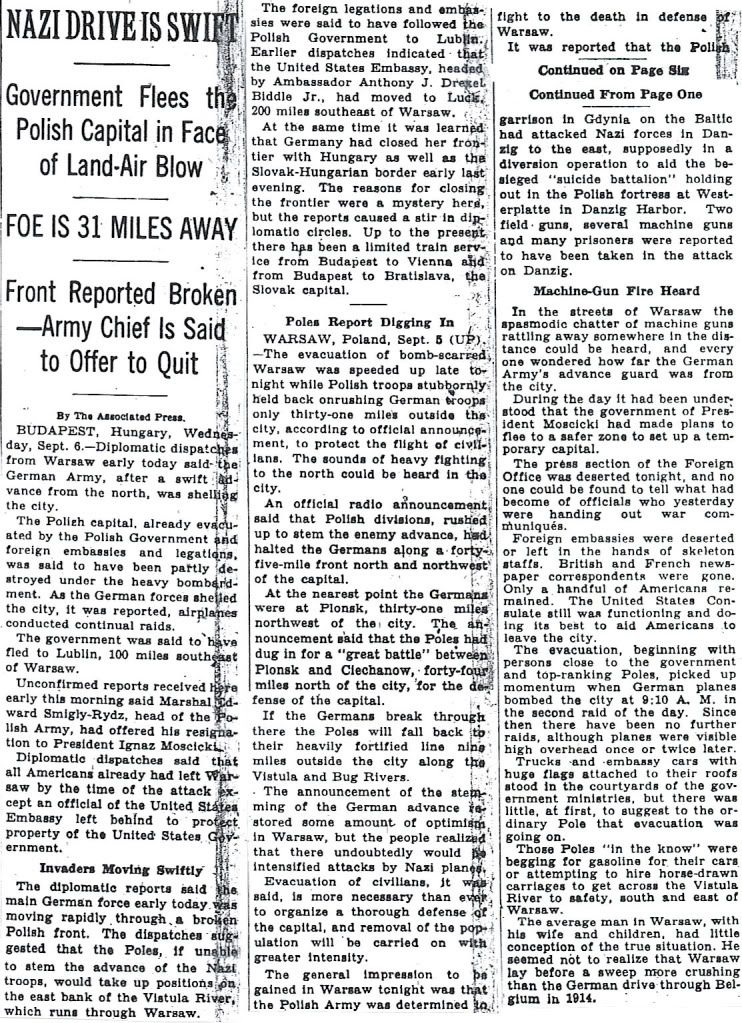

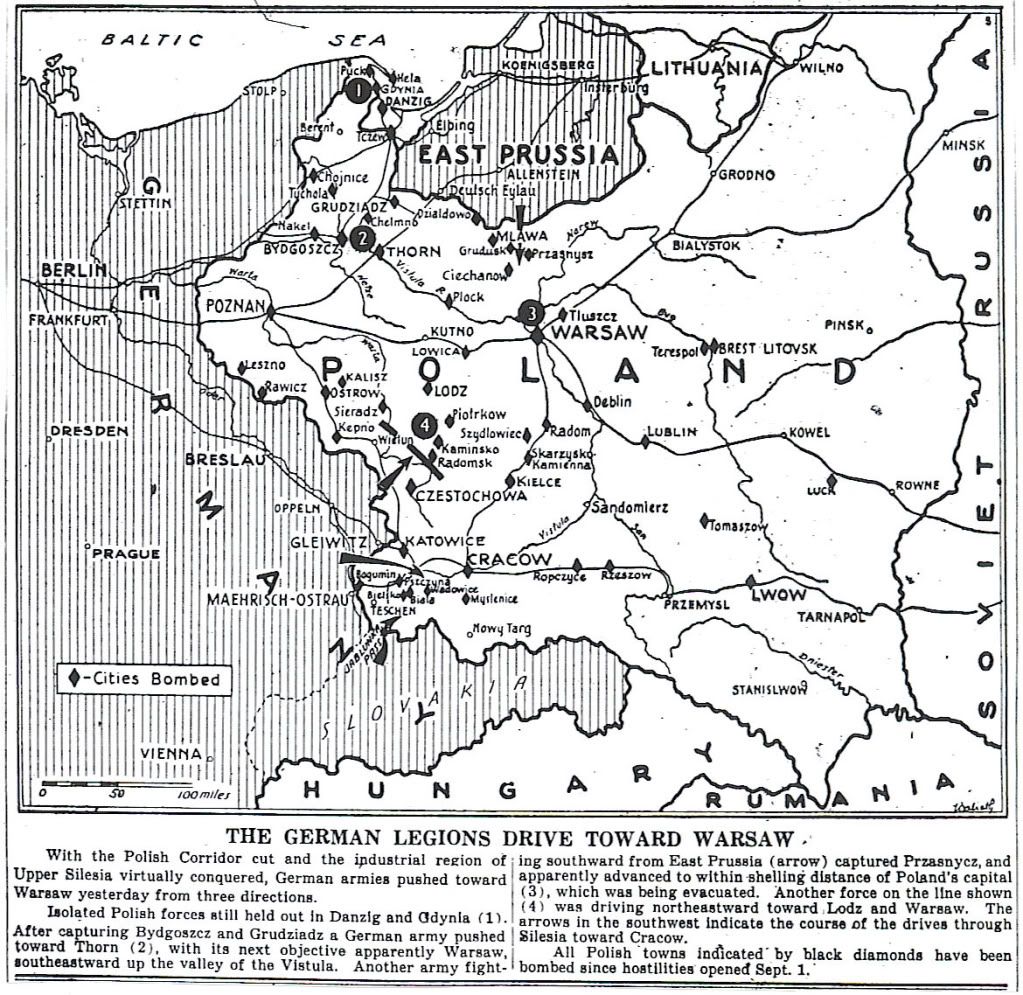

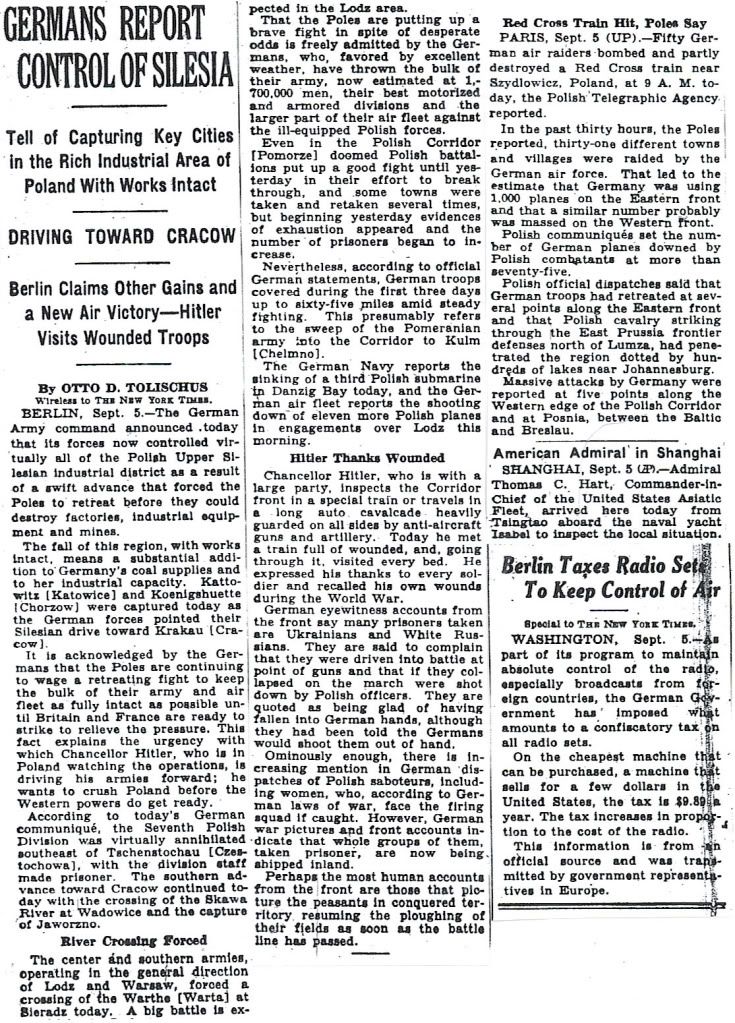

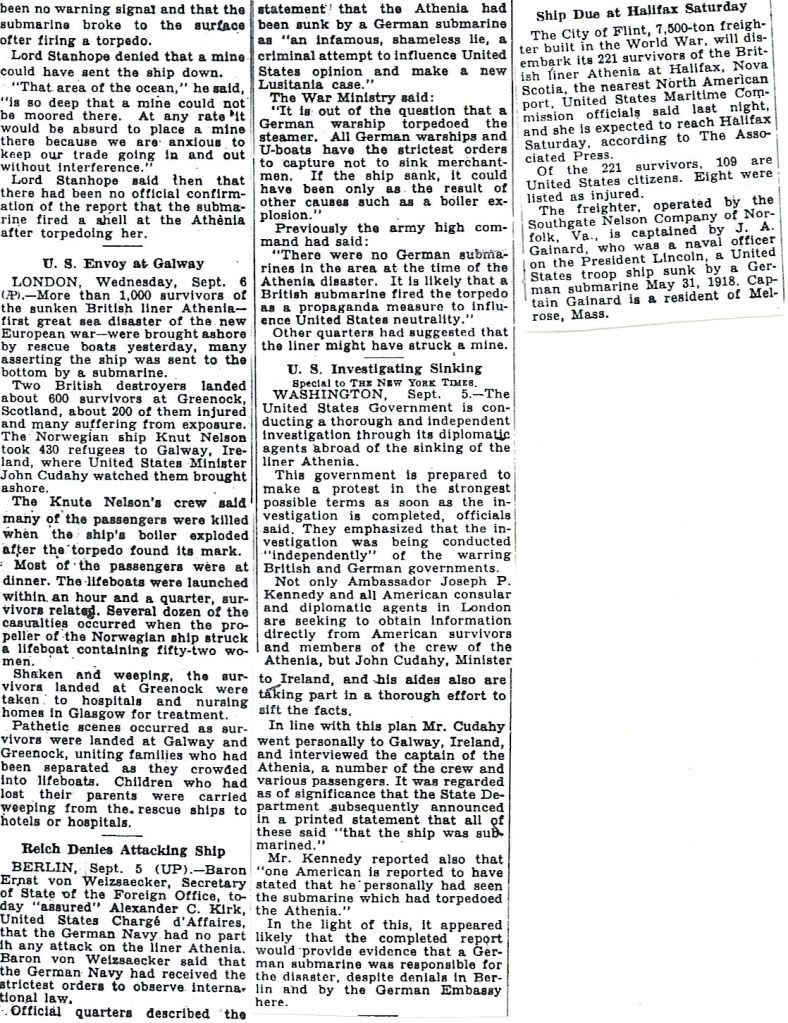





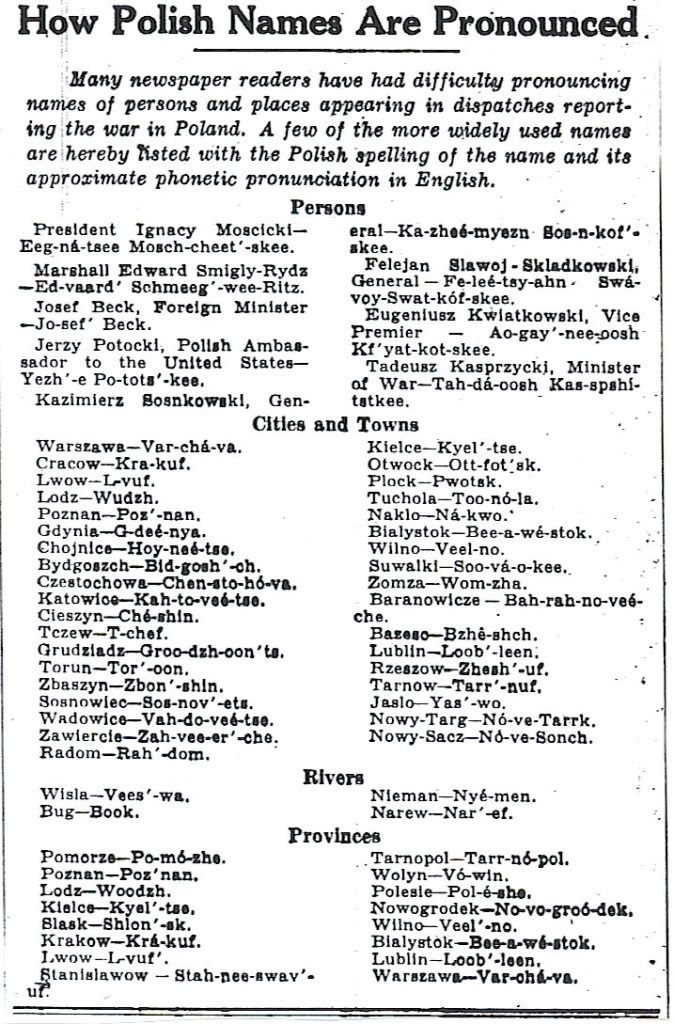

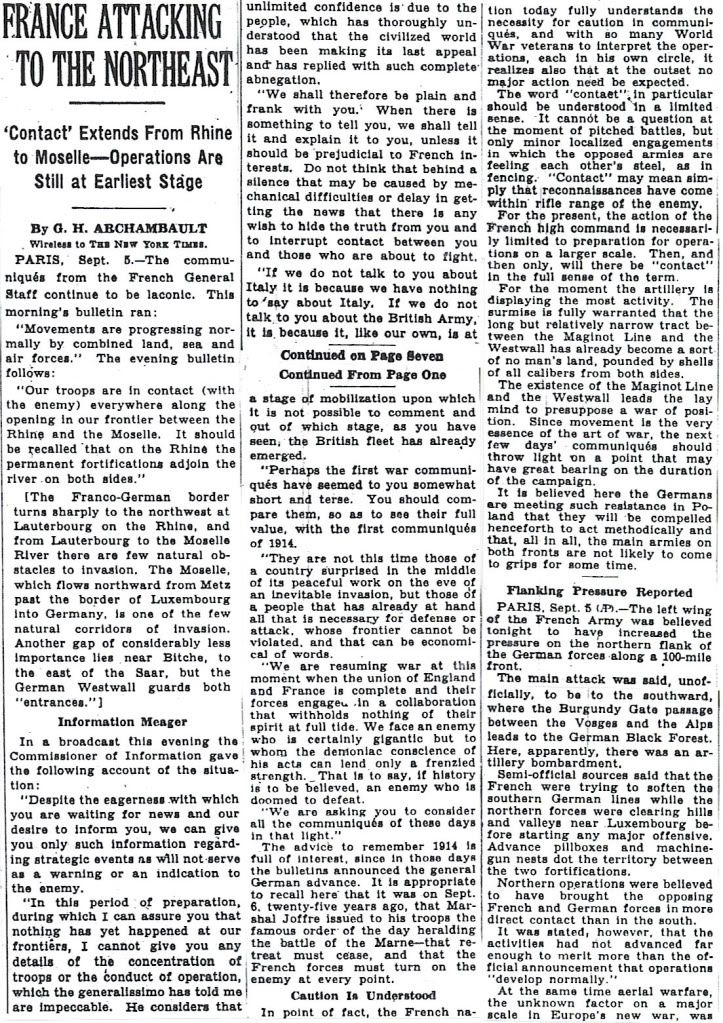



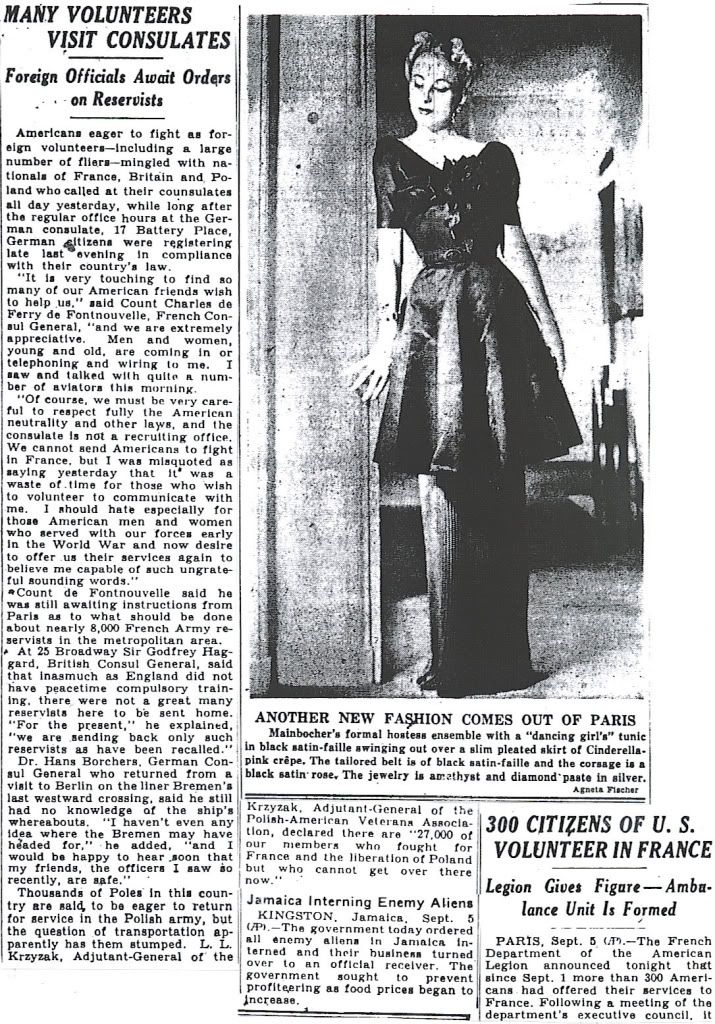

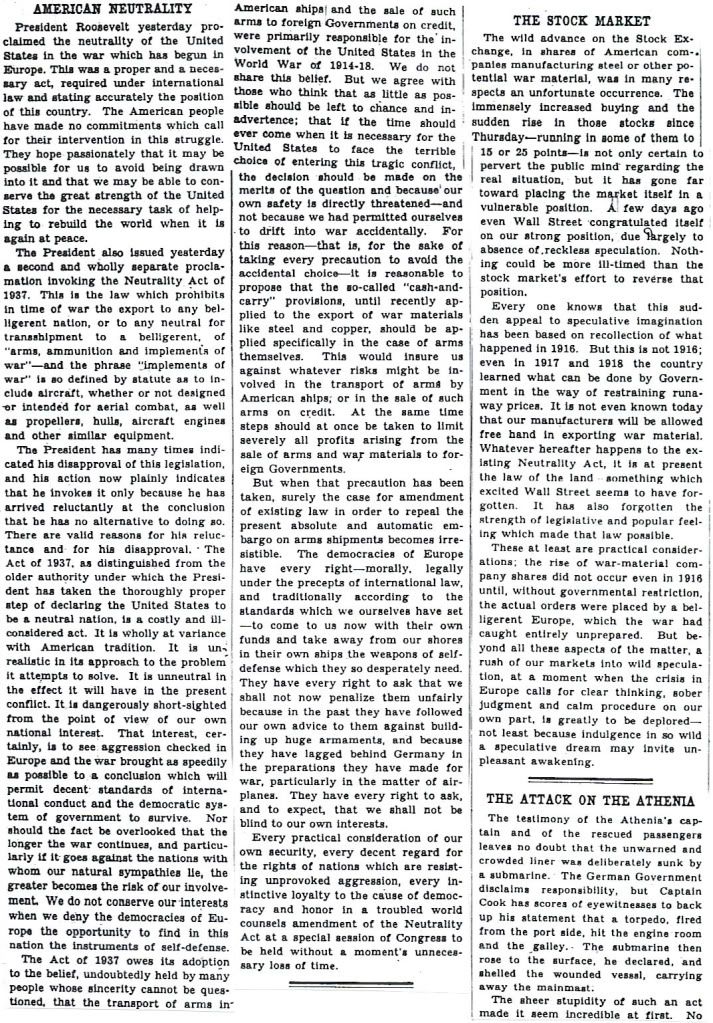

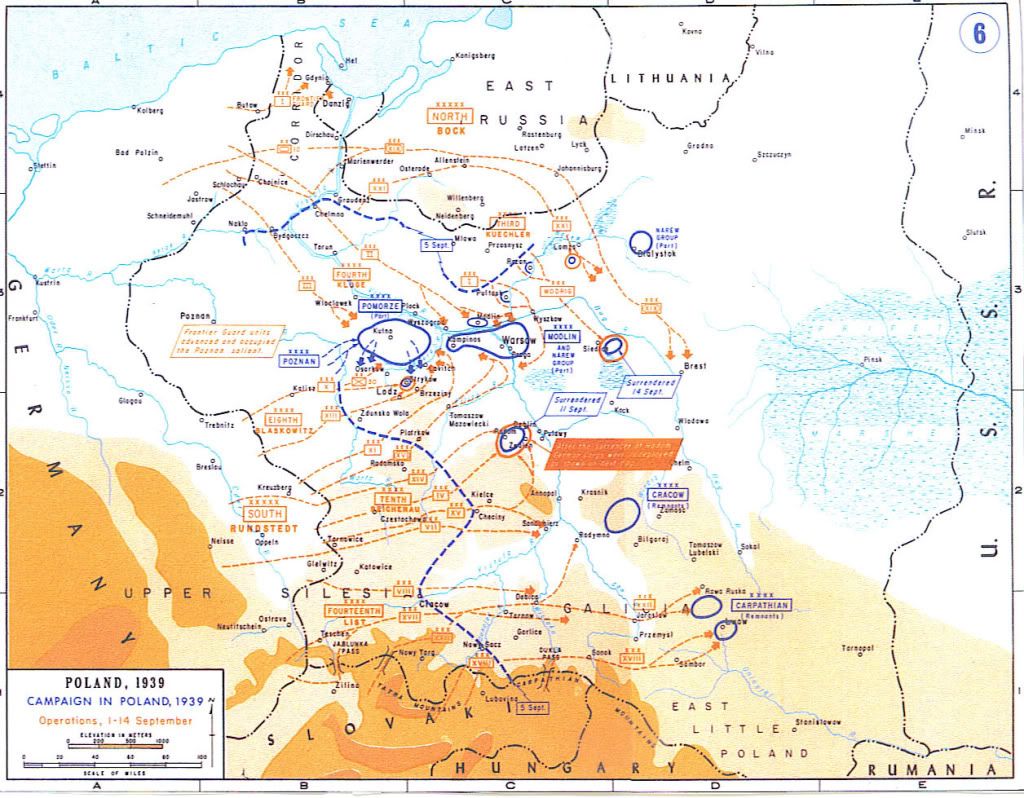
A key to the map symbols is on my profile.

http://www.worldwar-2.net/timelines/war-in-europe/eastern-europe/eastern-europe-index-1939.htm
Can I get on your ping list?
Thanks.
It would seem that most people realized at this point that Poland was doomed. Especially seeing that the Poles were depending on the French coming to their rescue.
http://www.raf.mod.uk/history/rafhistorytimeline1939.cfm
6 Sep 1939 - South Africa declares war on Germany. Also on this day is the Battle of Barking Creek, when a error in identification in the Chain Home Radar system led to RAF aircraft engaging each other over the Thames Estuary. Blenheims, Hurricanes and Spitfires, not physically unlike the German Ju 88 and Bf 109, reported seeing enemy aircraft and several claims were made.
http://en.wikipedia.org/wiki/Battle_of_Barking_Creek
The Battle of Barking Creek was an incident that happened on 6 September 1939, resulting in the first death of a British fighter pilot in World War II.
With the war only three days old, none of the Royal Air Force pilots had seen combat, very few had ever seen a German plane. Communications between planes and command centers were poor.
At 6.15am on 6 September, unidentified aircraft were reported approaching from the east at high altitude over West Mersea, on the Essex coast.
In response, six Hurricanes were ordered to be scrambled from 56 Squadron, based at North Weald Airfield in Essex. For some unknown reason the Squadron’s Commanding Officer, Group Captain Lucking, sent up his entire unit. In addition to these, and unbeknown to the rest of the pilots, two Pilot Officers managed to take up a pair of reserve aircraft and followed at a distance, destined to be the object of the mistaken attack.
Additionally, 151 Squadron’s Hurricanes (also from North Weald), and Spitfires from 54, 65, and 74 Squadrons based at Hornchurch Airfield scrambled.
‘A’ Flight of 74 Squadron saw what they believed were enemy planes and were given permission to engage them. Two of the three, Flying Officer Paddy Byrne and Pilot Officer John Freeborn, opened fire.
One Hurricane was piloted by Frank Rose, who was shot down but survived. The other was flown by Pilot Officer Montague Hulton-Harrop, who was shot down by John Freeborn.
Hulton-Harrop was hit in the back of the head and was dead before his plane hit the ground. It crashed at Manor Farm, Hintlesham, Suffolk, approximately five miles west of Ipswich. He was the first British pilot fatality of the war. His Hurricane was also the first plane shot down by a Spitfire. The entire air-raid warning turned out to be false.
At the ensuing court martial both of the Spitfire pilots were exonerated, the court ruling the case as an unfortunate accident. The leader of the flight, Sailor Malan, was not charged. Group Captain Lucking was removed from his post as Commanding Officer of 56 Squadron.
Montague Hulton-Harrop is buried with a war grave headstone in at St Andrew’s Church in North Weald.
John Freeborn flew for the rest of the war and proved to be an outstanding pilot. He flew more operational hours in the Battle of Britain than any other pilot. He was awarded the DFC and bar and rose to be a Wing Commander.
“This tragic shambles, hushed up at the time, was dubbed in the RAF ‘the Battle of Barking Creek’ – a place several miles from the shooting-down but one which, like Wigan Pier, was a standing joke in the music halls.” - Hough, Richard and Denis Richards. ‘The Battle of Britain: The Greatest Air Battle of World War II’, WW Norton, 1990, p.67
http://www.northwealdairfieldhistory.org/content/battle-barking-creek
The Battle of Barking Creek
http://www.rbl-epping.org.uk/hisbcreek.html
THE BATTLE OF BARKING CREEK
FIGHTER COMMAND’S FIRST FATALITY OF WORLD WAR II –
AN EARLY VICTIM OF ‘FRIENDLY FIRE’
bkmk
Some excerpts from The German Campaign in Poland: September 1 to October 5, 1939
Prepared under direction of the Chief of Staff
United States Government Printing Office
Washington: 1942
b. Phase II: September 6-8-Decisive German victory.
(1) Fourteenth Army (List).-- The divisions of the Polish Cracow and Przemysl Army Groups facing the Fourteenth Army drew back rapidly toward the San River line without offering decisive battle.
The course of their retreat indicated that they hoped to organize a broad but firm defense of that line between Sandomierz, at the junction of the San and Vistula Rivers, and Przemysl. The withdrawal, however, was marked by considerable disorder. There were many indications that Polish GHQ at Warsaw, even at this early stage of the campaign, had lost touch with its southern army groups, compelling the commanders of these groups to act on their own responsibility.
On September 6, without opposition, the Mahrisch Ostrau group of the Fourteenth Army captured Cracow, principal city of southern Poland. The same day the Sillein group occupied Neu Sandez. On the 8th the Galician towns of Gorlice, Pilzno, and Tarnow were taken and a bridgehead, was seized at Debica on the east bank of the Wisloka River.
The operations of the Fourteenth Army between the 6th and 8th were not decisive and the San River line was still intact, but the disorganized withdrawal of the Polish forces caused the German High Command to believe that no effective resistance would be encountered on that line.
(2) Tenth Army (von Reichenau).--On September 5 this army was stretched on a broad front from Piotrkow to Checiny. A panzer corps under General of Cavalry Hoepner was concentrated around Piotrkow, while the other panzer corps of the army, commanded by General of Infantry Hoth, guarded the right flank against a hostile attack from the enemy divisions to the south around Cracow.
The four Polish divisions which had originally opposed the Tenth Armyís assault began to withdraw northward towards Lodz on September 5 while the reserve divisions retired eastward toward the Vistula. The latter divisions were preparing to halt a German pursuit along the line of the Lysa Gora Hills in front of Radom.
The parting of these two forces of the Polish Lodz Group was due to the rapid advance of the two German panzer corps. One Polish force moved northward and the other eastward thereby opening a broad and inviting gap in front of the Tenth Army's left wing and center. Between Piotrkow and Warsaw stood no Polish force of consequential size. And between these two cities ran the best paved road in all Poland. At Piotrkow was poised General Hoepner's powerful panzer corps of two armored divisions. Here was a unique situation offering armored forces an opportunity to show their strategic capabilities.
General Hoepnerís panzer corps dashed into the gap and reached Tomaszow Mazowieckie on September 6. On this day and on the 7th and 8th the operations of the Tenth Army amounted to a headlong race to the Polish capital. One column of the panzer corps captured Rawa Mazowiecka on the 7th and was in the southwestern suburbs of Warsaw by evening the following day.
Another column of the panzer corps, operating on the right, took a more easterly route, swinging from Tomaszow Mazowieckie toward Gora Kalwaria on the west bank of the Vistula. Then it followed the river bank northward toward the Polish capital. On the evening of the 8th this column also was in the suburbs of Warsaw.
Neither column, however, was sufficiently concentrated on this evening to undertake occupation of the city. German infantry divisions were reported to be 70 miles in rear of their armored corps. Very strong and undefeated Polish forces were believed to be in and around Lodz, threatening the left flank and rear of the panzer force.
Hoepner's deep wedge between the Polish armies had changed the strategic situation overnight. Strong elements of the Thorn, Posen, and Lodz Army Corps stood on the west of this wedge. Widely scattered forces were on the east. The wedge stood between these Polish forces and their traditional river defense, the Vistula. While the left wing of the Tenth Army advanced on Warsaw, the center and right continued toward the Lysa Gora Hills mass and Radom. The important industrial city of Kielce fell on the 6th. On the 7th the Army attacked the 3d and 12th Polish divisions frontally around Skarzysko-Kamienna.
The withdrawal of the Polish Cracow Army Group from Cracow relieved General Hoth's panzer corps of the necessity of protecting the Tenth Army's right flank. Now its mission was to prevent the enemy's withdrawal from Radom and the Lysa Gora Hills to the safety of the Vistula.
Driving swiftly from its position southeast of Kielce, the panzer corps advanced northward along the west bank of the Vistula and captured Zwolen and Radom during, the afternoon and evening of the 8th. This cut the line of retreat of the 3rd, 12th, 19th, and 29th Polish divisions. On the 8th a flanking detachment captured Sandomierz and its munitions factories.
Although the line of retreat of the Polish divisions was severed, they were still intact and the panzer corps lacked the power to defeat them. Nevertheless the advance to Radom was of extreme strategic importance, for the southern Polish front was shattered, the four divisions were in jeopardy, and the Polish hold on the middle Vistula front, the last natural line of defense, was seriously threatened.
(3) Eighth Army (von Blaskowitz).--During this phase of the campaign the Eighth Army continued to advance in a general northeasterly direction without important incidents. On the 8th the army passed on both sides of Lodz without occupying it, and toward evening reached the vicinity of Ozorkow, northwest of Lodz, and Brzeziny, to the northeast.
The 30th Division was echeloned to the left rear of the left flank of this army to prevent interference with its movements by the strong Polish forces in the province of Posen. On the 8th the Eighth Army was still entirely unaware that these Polish forces of about five divisions had begun to withdraw from Kalisch, Posen, and Thorn and were rapidly nearing the army's left flank.
The failure of the German intelligence service to observe this development was to result in a grave crisis for the Eighth Army in the following week and, momentarily at least, to jeopardize the entire German plan of campaign. Later the Germans stated that their failure to discover the assembling Polish mass was due to the fact that the Polish units marched at night, took cover in villages and woods in daylight, and did not fire upon aerial reconnaissance forces.
(4) Fourth Army. (von Kluge).--The operations of this army, which was numerically weakened on September 5 by the transfer of the 3d Panzer and 23d Infantry Divisions to the Third Army, were of relatively slight interest during this phase. The III Corps, constituting the right wing element of the Fourth Army, captured Bromberg on September 6 and by the 8th had advanced close to Hohensalza.
The II Corps established bridgeheads on the east bank of the Vistula on the 5th. By the evening of the 8th this corps had captured Strasburg and, to the south, had crossed the Drewenz River and advanced to Lypin. Only weak Polish detachments seemed to stand between this force and the fortress of Modlin.
During this phase all rail lines across the Corridor were repaired and placed in operation again.
(5) Third Army (von Kuechler).--By the night of September 5 the striking force of the Third Army stood in two groups, one at Ciechanow and the other facing Rozan on the Narew River. The day was spent in troop movements necessary to change the direction of this army. It had been attacking due south from East Prussia toward Modlin and Warsaw, but the army commander had never intended to plunge frontally against the fortifications protecting the Polish capital to the north. Now the army was turned southeastward, with the intention of driving over the Narew and Bug Rivers toward Siedlce, 50 miles east of Warsaw. The capture of Siedlce would isolate the Polish capital.
On the morning of the 6th the attack began. The Narew was forced near Pultusk and Rozan on the 7th after heavy fighting which the attacking troops suffered severe losses. The Polish bridgehead fortifications on the west bank at Rozan and Pultusk were masked and the crossing was effected on both sides of both cities. This action forced the Poles to evacuate both bridgeheads on the 7th. The Germans then began a pursuit toward the Bug River in the direction of Wyszkow and Brok. On the 8th, Polish Cavalry penetrated the southeastern area of East Prussia but was repulsed.
The forcing of the Narew opened a path to the interior of Poland. This was another success that profoundly influenced the entire situation, for the Narew River line was the only Polish defensive position north of Warsaw.
(6) Air operations.--During the period September 6-8 the German Air Force continued its operations against the airfields and communication systems of western Poland. Repeated heavy bombing attacks tore up the railroads leading from Thorn, Posen, and Kalisch to the Polish capital. These attacks were intended to retard the regrouping of the Posen and Thorn troops that were trying to retire westward.
On the 8th the German Air Force destroyed the Vistula bridges at Deblin, an achievement of more than local importance, for near Radom it aggravated the plight of the four Polish divisions whose retreat to the Vistula was menaced by General Hoth's panzer corps.
Most of the German airplanes brought down up to the end of this phase were not victims of enemy pursuit aviation or antiaircraft artillery but were shot down Polish infantrymen, with rifle fire.
(7) Polish Strategy.--With the lines crumbling on all fronts, the Polish High Command on the evening of September 6 had ordered its armies to retreat. The forces along the Narew River were ordered to recapture Rozan by counterattack and then to hold the river. But this action failed, and the troops were directed to relinquish the line of the Narew and retire behind the Bug River. Units in the vicinity of Modlin were to withdraw to the juncture of the Bug and the Vistula. The remnants of the Thorn Group and the army in the Province of Posen were to retire behind the Vistula, while the Lodz Group was to shift to the south of Warsaw, in the vicinity of Gora Kalwaria. Forces on the Pilica River were ordered to retreat to Annapol on the eastern bank of the Vistula, and the Przemysl Group and part of the Cracow Group received orders to take up positions on the Dunajec River, from its junction with the Vistula to the Carpathian Mountains.
At midnight on September 7 the General Headquarters of the Polish Army, which had already experienced considerable difficulty in maintaining contact with its armies in the field, decided to transfer from Warsaw to Brest Litovsk, a distance of approximately 120 miles.
Very interesting stuff. Thanks abb.
Neither column, however, was sufficiently concentrated on this evening to undertake occupation of the city. German infantry divisions were reported to be 70 miles in rear of their armored corps.
So even with innovative use of armor you still need infantry to consolidate your gains.
Very true. This action by the 10th Army was the first seperation of a Panzer corps from the infantry for use as a spearhead (very blitzkriegesque). But in the end the infantry does need to occupy gains.
As we will see in May the 1st Panzer Division along with the other Panzer divisions used as spearheads compensated for the need to occupy gains by motorizing infantry to keep up with the spearhead (including motorcycle infantry). Though if I remember correctly they did use the 10th Panzer as the sole protector of the Sedan bridgehead for a short period of time (I'll have to double check that).
I read this news story the same way I remember reading about the battles outside Saigon in 1975. I knew the South Vietnamese army had been whipped just because you could tell how much territory had been lost and how close the enemy was to the capital.
Same here; if the Germans are that close to Warsaw, you’ve got to assume the Polish army has been defeated in the field. At least, those conversant with military operations would assume so. But the Times is still trying to put on a good face for the Poles, claiming that their army is still intact, they didn’t intend to defend the frontiers but intended to defend the interior of the country behind natural lines. Also, the article mentions that the Poles are making quick counter-attacks with the “finest cavalry in the world.”
In actuality, nothing could be farther from the truth. The Poles did try to defend the frontiers. Other than the Poznan Group, their armies have been soundly beaten and are no longer fighting as cohesive units. There is still no media emphasis on the really crushing blow to the Polish Army by Reichenau’s 10th German Army.
I posted a quick bio on Reichenau, but it went on yesterday’s thread by mistake, so it probably didn’t get read. I’ll repost it:
There was an interesting bio on Reichenau in Shirer’s “The Nightmare Years.” Shirer met Reichenau several times in Germany before the war, and later traveled with Reichenau in Belgium when Reichenau commanded 6th Army in 1940. Shirer had a high opinion of Reichenau, even though Shirer knew he was a hard core Nazi. Anthony Beevor however described him as a “rumbustious thug.” Reichenau was definitely a hard driver, also very much an exercise/health enthusiast. When 10th Army reached the banks of the Vistula in Poland, Reichenau was the first German across. In front of his troops, he swam the river.
The stress of leading 6th Army and also Army Group South in the USSR later caught up with Reichenau. In the winter of 1941-42, while 6th Army was fighting bitterly for its survival against the Soviet counter-offensive, Reichenau went for one of his morning runs when the temperature was -20F. Later that day he suffered a massive heart attack and died before he could be returned to Germany.
German 6th Army was then commanded by a relatively unknown general named Paulus.
This will be a recurring problem for the Germans throughout the war. The Panzers are very good at opening holes and dashing through them, but get exposed repeatedly because the foot infantry with their horse drawn artillery labor to catch up. In France it will lead to several “stop” orders to the Panzer units in the dash to the Channel and envelopment of Dunkirk.
In the USSR they will cut off entire groups of Soviet armies, but without enough infantry the cordon is too loose and many Soviet soldiers will infiltrate back to Soviet territory to fight again, or melt into the woods to become partisans.
Cougar
This is an excellent summary of this part of the campaign; thanks for posting it. It really shows the contrast between what is being reported and what is really happening.
The “French Attacking to the Northeast” is pure unadulterated BS. (A technical term meaning “questionable.”)
The REAL French “Offensive” starts tomorrow; woo hoo! More on that then.
The article about Canada not declaring war and the speculation about this being designed to get around American neutrality was very interesting.
Excellent post!
Disclaimer: Opinions posted on Free Republic are those of the individual posters and do not necessarily represent the opinion of Free Republic or its management. All materials posted herein are protected by copyright law and the exemption for fair use of copyrighted works.